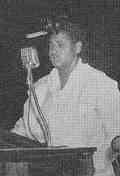


Arizona Dranes
Source: NPR
Preparing the way for modern gospel was "Arizona" Dranes by whose influence Thomas A. Dorsey turned from blues to gospel and the creation of the black gospel genre. Born blind in Sherman, Texas, just south of eastern Oklahoma, on 4 May 1889 (if not '91) as Juanita Drane (possibly Drain), Arizona is thought to have composed such as 'Crucifixion', 'Sweet Heaven Is My Home', 'God's Got a Crown', 'He Is My Story' and 'Just Look'. She learned piano as a teenager after attending the Texas Institute for Deaf, Dumb and Blind Colored Youth in Austin. Dranes is an apt example of the divergence of blues and gospel as well as the Holiness (Pentecostal) gospel of the Bible Belt region versus the black gospel that Thomas A Dorsey would center in Chicago. Like Dorsey, she had both merged blues and gospel in their sharing of common roots, and distinguished them separately, one secular for playing at barrelhouses, the other spiritual for performing in church. Dorsey was a Baptist but Pentecostals would soon take the reins. As mentioned, Dranes was Pentecostal as well, belonging to the Church of God in Christ in Wichita Falls.
Dranes first recorded with Okeh Records in 1926. Going by DAHR, she put away six tracks on 17 June beginning with 'In That Day' composed by herself toward Okeh 8380 and 'It's All Right Now' also authored by herself toward Okeh 8353.
'In That Day' Arizona Dranes Recorded 17 June 1926 Chicago
Matrix 9737 Issued on Okeh 8380 Composition: Dranes
'Crucifixion' Arizona Dranes Recorded 17 June 1926 Chicago
Matrix 9741 Issued on Okeh 8380 Composition: Dranes
'God's Got a Crown' Arizona Dranes Recorded 3 July 1928 Chicago
Matrix 8W400981 Issued in 1976 on Library of Congress LBC-1 & Herwin H210 (below)
Dranes toured into the forties, drawing attention to black gospel in general before settling in Los Angeles in 1948. She there passed away on 27 July of 1963, black gospel yet rowing strong in its golden period. Among Dranes' greatest contributions was simply adding piano to gospel music that was usually performed by a capella choral groups, then arranging voice to emphasized piano rather than using the instrument only for accompaniment. Roberta Martin would later make similar use of the piano in gospel.
Sources & References:
Michael Corcoran (He Is My Story / Tompkins Square 2012):
Diverse Arts (excerpt)
Ted Olson (review)
Catalogs:
Compilations:
Herwin 210 (1976)
Library of Congress LBC-1 1976:
Sessionographies:
Further Reading:
TSHA
Classical Main Menu Modern Recording
hmrproject (at) aol (dot) com